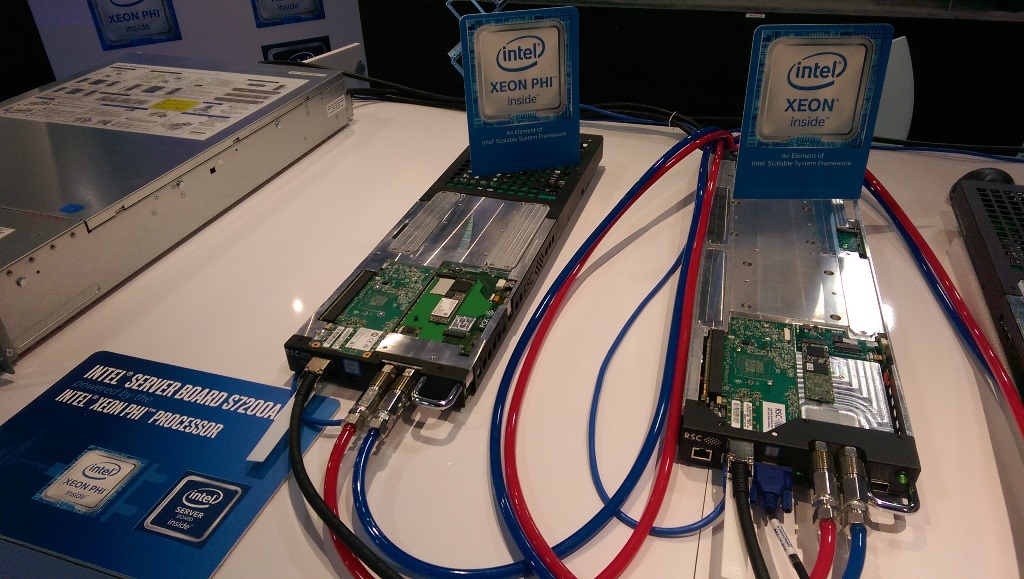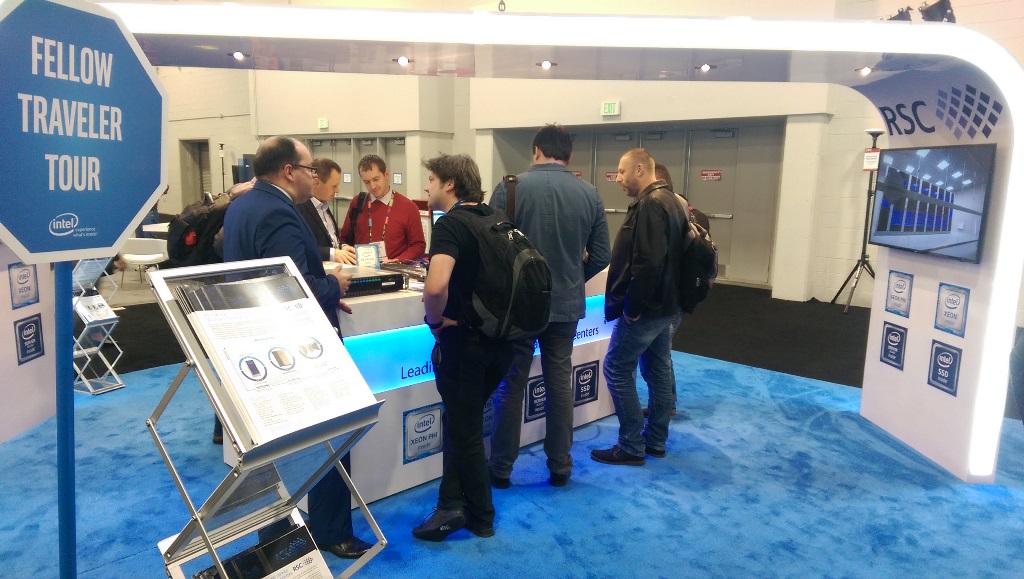RSC Group, a leading Russian HPC vendor, presented at SC16 supercomputing conference and exhibition a new generation of high-performance scalable and energy-efficient RSC Tornado solution with direct liquid cooling based on the 72-cores Intel® Xeon Phi™ 7290 processor setting a new world record of computing density for x86 architecture of 1.41 Pflops per rack.
Salt Lake City (USA), Supercomputing Conference (SC16), November 16, 2016 — RSC Group, the leading developer and system integrator of innovative solutions for high-performance computing (HPC) segment and Data Centers in Russia and CIS demonstrated a new generation of its high performance, scalable and energy-efficient RSC Tornado solution with direct liquid cooling based on the 72-cores Intel® Xeon Phi™ 7290, a top-bin model in this processor family, at SC16 international supercomputing conference and exhibition. This new RSC solution has set a new world record of computing density for x86 architecture of 1.41 Pflops per rack increasing a previous record by 17% (another RSC’s solution – RSC PetaStream – had hold the world record of 1.2 Pflops per rack since 2013). RSC Tornado solution based on multi-core Intel® Xeon Phi™ 7200 processor family has improved footprint and computing density, high energy efficiency, ease to manage and maintain as well as provides stable operation of computing nodes in “hot water” mode at +63 °С cooling agent temperature at node inputs. This confirms RSC’s leading position in the field of bringing the latest technologies for global supercomputer industry to the market and meeting growing customer demands.
RSC Tornado computing node based on Intel® Xeon Phi™ 7290 multi-core processor, Intel® S7200AP server board with two Intel® SSD DC S3500 Series M.2 340 GB and one Intel® SSD DC P3100 (M.2 NVMe) solid state drives (PCIe interface) has been demonstrated at RSC booth as well as switches and adapters based on Intel® Omni-Path Architecture (OPA) and Mellanox EDR InfiniBand high-speed interconnects.
RSC provided the technology sponsorship for German student team from Technical University of Munich (TUM) which was participating again in Student Cluster Competition (SCC) at SC16. The Student Cluster Competition is a real-time, non-stop, 48-hour challenge in which teams need to complete and tune a real-world workload across a series of scientific applications on a cluster from commercially available components and not exceeding a 3120 watt power limit, demonstrate knowledge of system architecture and application performance, and impress HPC industry judges. Russian company supported the German youth team with 8 nodes mobile cluster based on RSC Tornado direct liquid cooled architecture. This computing system provided stable operation of computing nodes in “hot water” mode at +63 °С cooling agent temperature at node inputs and had the following configuration: 72-cores Intel® Xeon Phi™ 7290 processors, Intel® S7200AP server boards, Intel® SSD DC S3500 Series M.2 340 GB solid-state drives, switch and adapters based on Intel® Omni-Path high-speed fabric, highly efficient Micron DDR4-2400 VLP 16-32 GB memory modules.
RSC also demonstrated at SC16 a storage solution utilizing the newest NVMe-over-Fabric protocol features. This is an extension to the original NVMe specifications that allows accessing remotely connected NVMe SSDs over RDMA-enabled fabric. Russian company showed at its booth a basic infrastructure of NVMe-over-Fabric Target system with multiple Intel® SSD DC P3700 disks and connected via NVMe-over-Fabric hosts (RSC Tornado nodes based on Intel® Xeon Phi™ 7290 processors) over Intel® Omni-Path fabric switch. Such approach allows to address a block devices remotely with “close to local latency” which can be implemented in the I/O Node designs in HPC. To be noted, this is not a replacement to a traditional parallel storage - I/O nodes boost random I/O performance in the most effective way. Such example can be partitioning a SSD into multiple partitions, sharing them to compute nodes when it’s needed for a workload. This can be used as “scratch on demand” option available upon to request without reboot and re-configuration of a compute nodes.
RSC Tornado solution features
New generation of RSC Tornado cluster solution has the following improved characteristics:
· usage of high-end models of multi-core Intel® Xeon Phi™ 7200 processor family, including the top-bin Intel® Xeon Phi™ 7290 (72-cores) and support of the upcoming Intel® Xeon Phi™ 7250F, Intel® Xeon Phi™ 7290F processors (“F” indicates processor versions with integrated high-speed interconnect Intel® Omni-Path),
· Intel® S7200AP server boards,
· the highest physical density with up to 408 computing nodes in a dual-side 42U cabinet (120х120х200 cm),
· the record level of computing density – 1.41 Pflops (528 Teraflops in a previous generation) in a dual-side 42U cabinet or over 490 Teraflops/m3,
· the power density with up to 200 kW per rack allows, thanks to reducing of a system power consumption, to increase an energy efficiency by 3 times,
· increased RAM volume usage per rack by 5 times from 16.5 TB to 76.5 TB (up to 192 GB RAM DDR4-2400 RAM and 16 GB MCDRAM per node),
· simultaneous use of up to 2x SSD SATA drives and one PCIe SSD in M.2 form factor, such as Intel® SSD DC S3500 series and Intel® SSD DC P3100 (M.2 NVMe),
· improved energy efficiency – provides necessary conditions for stable operation of computing nodes in "hot water” mode at +63 °С temperature at node input enabling system free-cooling operation in 24x7x365 mode with outstanding PUE of 1.05 and even less,
· a new power supply module in computing node form factor providing efficient transformation of 220V AC to 400V DC (with 96% efficiency) and supporting parallel operation on common bus with reservation scheme from N+1 to N+N,
· updated design of computing cabinet with support of new high speed inter-node communication technologies including Intel® Omni-Path and Mellanox EDR InfiniBand,
· support of flexible colling system configurations with redundancy of both single hydraulic regulation nodes and the entire system,
· any RSC Tornado node is serviceable separately without stopping any other node. All node components (memory, disks, high-speed interconnect adapters, power and management subsystems) are easily accessible for simple replacement or re-configuration of these components directly at the customer's site.
RSC Tornado cluster solution can also be implemented with Intel® Xeon® E5-2600 v4 server processor family, including high-end model Intel® Xeon® E5-2699A v4 just has been introduced at SC16 (22 cores, 2.40 GHz, 55 MB L3 cache) and providing a high computing density – 258.5 Teraflops in a standard 42U (80x80x200 cm) cabinet.
Innovative management and monitoring system of RSC solutions for high-performance computing also provides high availability, resistance to failures and ease of use. It can be used to manage single nodes and the entire solution, including infrastructure components. All elements of the system (computing nodes, power supplies, hydraulic regulation modules, etc.) have an integrated management module providing broad capabilities for detailed telemetry and flexible management. Cabinet design supports replacement of computing nodes, power supplies and hydraulic regulation modules (with redundancy) in hot-swap mode without interruption of system operation. Most components of the system (such as computing nodes, power supplies, network and infrastructure components, etc.) are software-defined, and this significantly simplifies and speeds up initial deployment, maintenance and future upgrades of the system. Liquid cooling of all components ensures their longevity.
Latest innovative approaches in new generation of RSC Tornado cluster solution enabled reduction of infrastructure costs within the scope of computing system development and provided capabilities for more flexible upgrades of single nodes and the entire system.
Therefore, RSC solutions for high-performance computing keep setting de facto high industry standards of physical and computing density, energy efficiency, reliability, availability and manageability.
Russian customers use solutions based on RSC Tornado cluster architecture with liquid cooling developed by RSC Group specialists in production environments for over six years. These solutions are installed and actively used for modeling and calculation of a broad range of scientific, research and industrial tasks by the St. Petersburg Polytechnic University named after Peter the Great (SPbPU), Joint Supercomputer Center of the Russian Academy of Sciences (JSCC RAS), South Ural State University (SUSU), Moscow Physics and Technology Institute (MIPT), Russian Weather Forecast Agency (Roshydromet) and other customers from different vertical industries.





